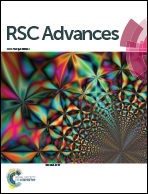Synthesis of Sn–Co@PMMA nanowire arrays by electrodeposition and in situ polymerization as a high performance lithium-ion battery anode†
Abstract
Transition metals have attracted much attention due to their high energy density in lithium-ion batteries (LIBs). However, the huge volume change and the fast capacity fading still limit their application. If the microstructure of the electrode materials can be designed properly, the volume change problems encountered during lithiation and delithiation could be alleviated to some extent. Here, novel three-dimensional (3D) hybrid Sn–Co nanowire arrays coated by poly(methyl methacrylate) (Sn–Co@PMMA NWs) are synthesized via a simple electrodeposition method followed by in situ emulsion polymerization. The electrode structure is well preserved after repeated Li-ion insertion/extraction, indicating that the positive synergistic effect of the Sn–Co NWs and uniform PMMA layer could effectively accommodate the volume expansion of tin anode materials. The electrochemistry results demonstrate that the Sn–Co@PMMA NWs electrode exhibits a high reversible capacity, a high initial coulombic efficiency, a good rate capability, and an improved capacity retention compared with the bare Sn–Co NWs electrode. This proposed nanoengineering strategy is proven to be an ideal candidate for the development of high performance anode for LIBs.


 Please wait while we load your content...
Please wait while we load your content...